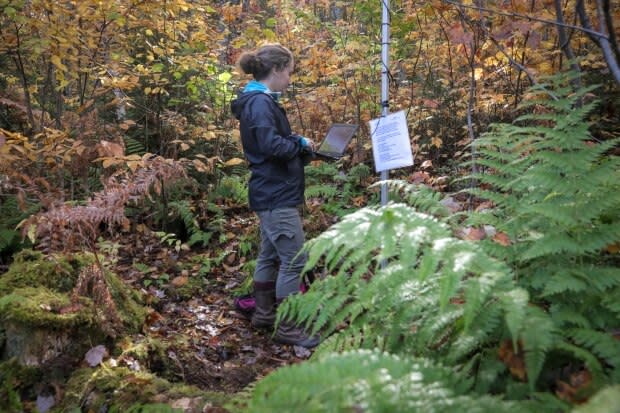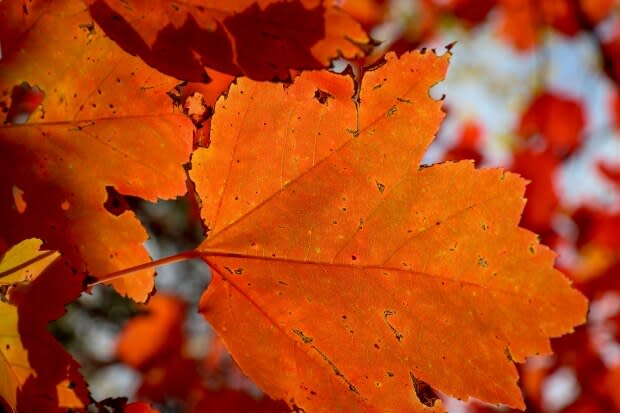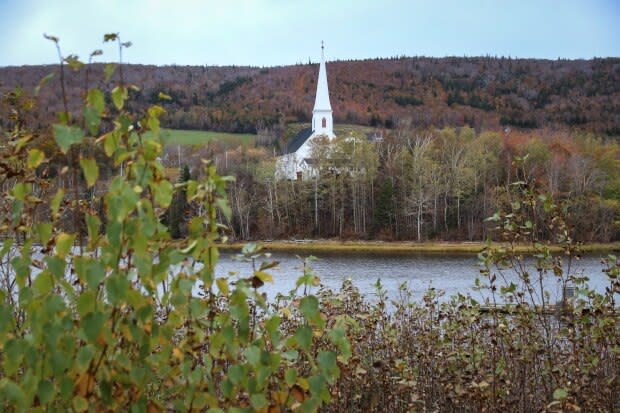How does climate change affect the fall colours? One researcher aims to find out
Lynsay Spafford trekked through thick brush, sinking in mud and pushing back tree branches, as she made her way toward her research station near Whycocomagh, N.S., on Cape Breton Island.
There, she collected images from one of 13 cameras she's set up at various sites around the province, capturing six images per day of 300 trees. Together, they give her a bigger picture as she studies the impact of climate change on the fall foliage.
"We have been observing in the last few decades leaves are coming out earlier and earlier with increased air temperatures," Spafford said.

Leafing phenology, or the timing of the leaf life cycle, including when leaves emerge from their buds and when they fall off, can be influenced by a variety of factors, including air temperature, humidity, sunlight and extreme weather.
Spafford, a master's student in environmental science at Memorial University of Newfoundland and St. Francis Xavier in Antigonish, N.S., has teamed up with Nova Scotia's Department of Natural Resources, sharing data to help inform conservation efforts and future resource management. Her work may even provide information about whether some tree species are more susceptible to changes in air temperature and humidity.

The stationary cameras provide a series of photographs of the same trees over time. Using software, Spafford is able to dissect the colour of the images.
"I can observe, 'Well, on May 2, this tree emerged from its buds and started leafing.' Or, you know, 'On Oct. 1, this tree transitioned from green leaves to yellow leaves,'" she said.

This spring, Spafford observed that on average, leaves on trees in southwestern Nova Scotia emerged two days earlier than those in the northeastern part of the province.
Analyzing the fall data will take some time, but as she downloaded the latest images from her camera, Spafford noted various species showcased their colours at different rates.

The role of extreme weather
Spafford said Hurricane Dorian could be blamed for the brown patches that can be seen on some parts of Cape Breton this year.
"The leaves are moving around rapidly. They might sever some of the leaf veins that transport water and nutrients that sustain the leaves, so we might see a quicker process going from green leaves to brown leaves," she explained.

Cape Breton's Cabot Trail is recognized as one of the best places in the world to view fall colours. It draws tens of thousands of visitors from more than 20 countries each year, particularly during the Celtic Colours music festival in October.
"I'm from Michigan and we have colour, but we don't have tremendous vistas of colour!" said Loretta Slayter, who was in Cape Breton for this year's festival.

Terry Smith, CEO of Destination Cape Breton, said that's why the fall foliage is so important to those who work in the tourism industry, and why brown leaves are of particular concern.
"Especially where it was wide open and unprotected to the wind, we did see a lot of browning and that was the week after Dorian, so that was really concerning to us," Smith said, noting he often gets calls from people wanting to plan their trips around the timing of the colours.

He said understanding the timing of the fall colours helps tourism operators, like food trucks, restaurants and inns, determine the timing of their season.
"We've been trying to encourage people to open a little bit longer, but if the leaves aren't there, that may impact people coming to visit," Smith said.
If climate continues to impact the leaves, he said tourism operators may have to change the way they do business.



